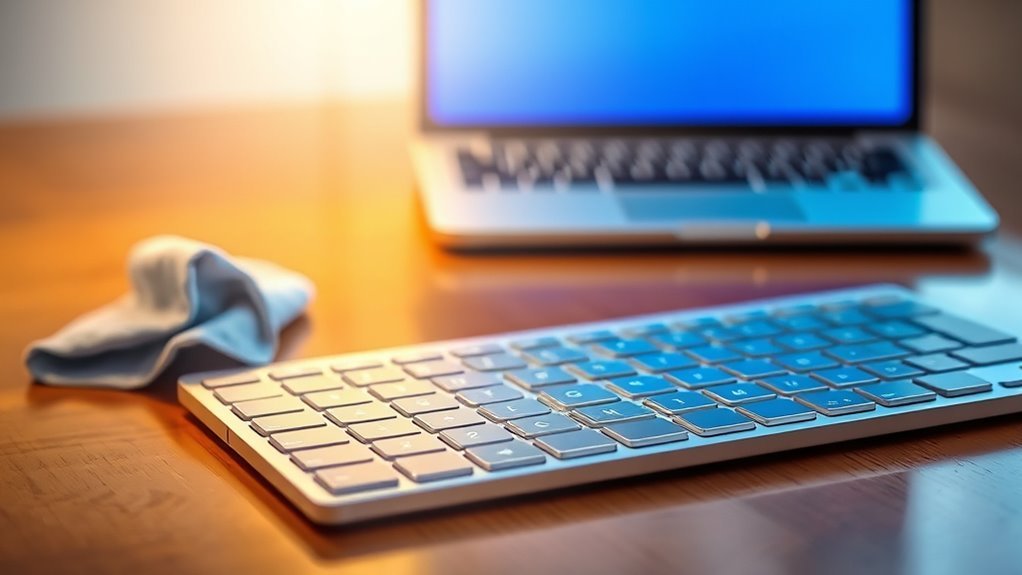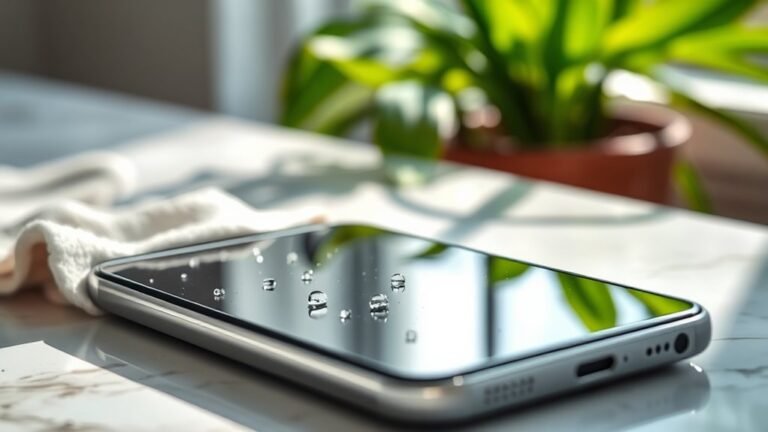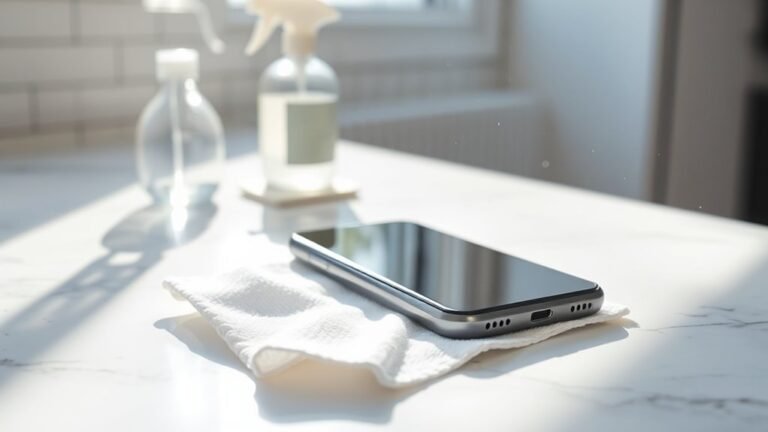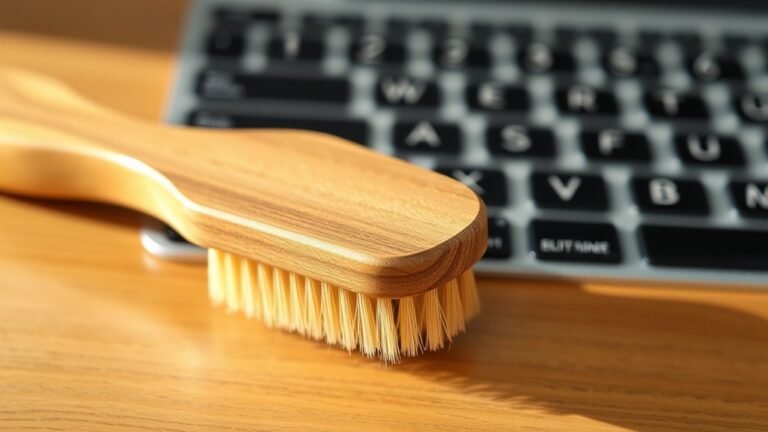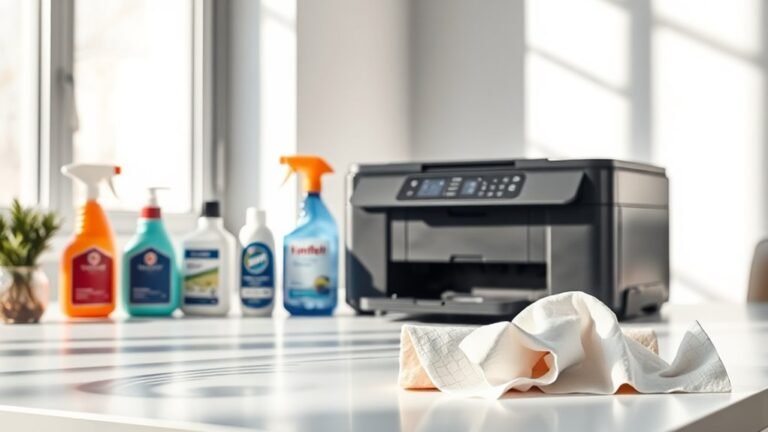Best Way to Sanitize Your Keyboard
To sanitize your keyboard effectively, first unplug it and use compressed air to dislodge debris between keys. Lightly dampen a microfiber cloth with 70% isopropyl alcohol or an electronics-safe disinfectant and gently wipe all surfaces without saturating. Avoid harsh chemicals that can damage the keyboard. Mechanical keyboards benefit from keycap removal for deeper cleaning. Regular sanitization prevents germs and maintains performance. Understanding the right tools and cleaning frequency guarantees your keyboard stays hygienic and fully functional.
Why Keyboard Hygiene Matters
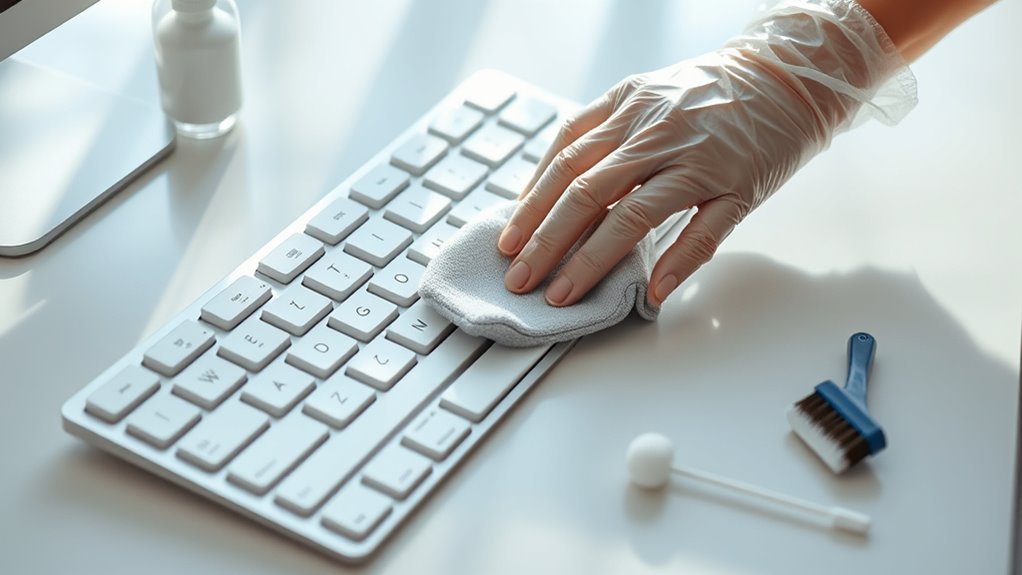
Although you might not realize it, your keyboard can harbor a significant amount of bacteria and viruses due to frequent contact with your fingers and face. Keyboard bacteria thrive in this environment, posing substantial health risks, including respiratory infections and skin irritations. Ignoring keyboard hygiene compromises your well-being and productivity, limiting your freedom to work or communicate effectively. Understanding these risks empowers you to take control of your environment by prioritizing cleanliness. Regularly sanitizing your keyboard reduces microbial presence, preventing contamination and illness. This proactive approach enhances your health security, enabling you to maintain a safe and efficient workspace. By recognizing why keyboard hygiene matters, you’re equipped to defend against invisible threats, preserving both your personal freedom and overall health. One effective method involves using isopropyl alcohol to disinfect keyboard surfaces safely and thoroughly.
Tools Needed for Effective Keyboard Cleaning
To sanitize your keyboard effectively, you’ll need specific tools designed for precision cleaning and disinfection. Essential supplies include microfiber cloths, compressed air, and soft brushes, while recommended sanitizing agents focus on isopropyl alcohol solutions at appropriate concentrations. Using the correct combination guarantees thorough removal of debris and microbes without damaging your device. It is important to avoid harsh chemicals like bleach or ammonia to protect the keyboard finish during cleaning.
Essential Cleaning Supplies
A few essential tools will guarantee you clean your keyboard thoroughly and safely. You’ll want to assemble supplies that not only remove grime but also disinfect without damaging sensitive components. Focus on precision and effectiveness by choosing:
- Disinfecting wipes: Make sure they’re alcohol-based but not overly saturated to prevent moisture damage.
- Cleaning solutions: Use those formulated for electronics, avoiding harsh chemicals.
- Microfiber cloths: Ideal for capturing dust and applying cleaning agents without scratching.
- Compressed air canister: Essential for blowing out debris from between keys without physical contact.
With these tools, you maintain full control over the cleaning process, ensuring a sanitized keyboard that functions flawlessly. Avoid improvising with unsuitable materials to protect your device’s longevity and your own health freedom.
Recommended Sanitizing Agents
Selecting the right sanitizing agents is essential for effectively disinfecting your keyboard without compromising its components. You should prioritize disinfectant wipes specifically formulated for electronics; these contain appropriate concentrations of alcohol and other agents that eliminate germs while preventing damage to delicate circuits. Alternatively, using alcohol solutions with at least 70% isopropyl alcohol guarantees rapid evaporation and effective microbial kill rates. Avoid harsh chemicals like bleach or ammonia, which can corrode key surfaces or degrade printed characters. When applying alcohol solutions, dampen a lint-free cloth rather than spraying directly to control moisture exposure. By choosing disinfectant wipes or properly diluted alcohol solutions, you maintain your keyboard’s integrity and hygiene, granting you the freedom to use your device safely without risking hardware failure or health concerns.
Step-by-Step Guide to Sanitizing Your Keyboard
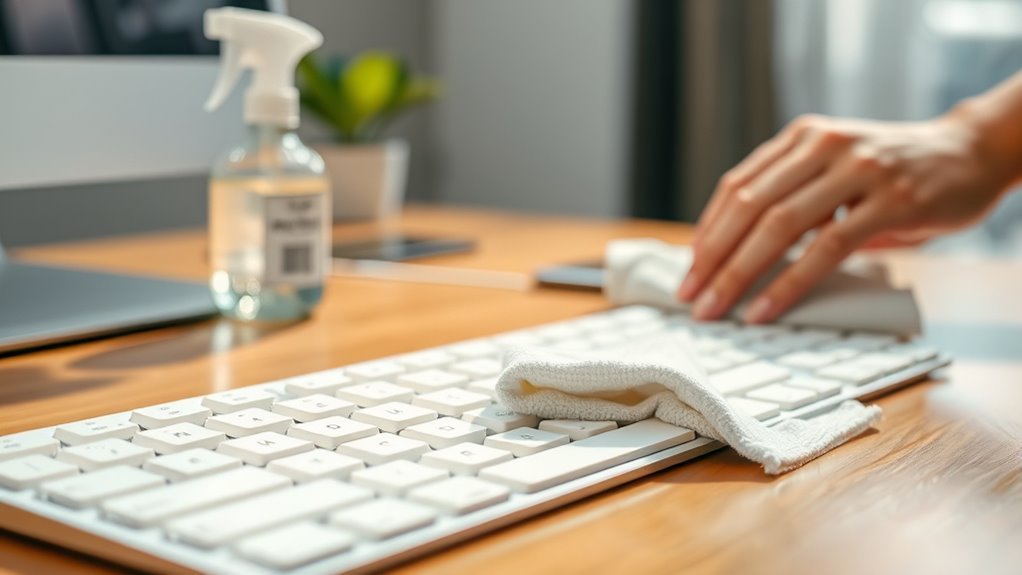
Power down and unplug your keyboard to prevent electrical damage.
Use compressed air to dislodge debris trapped beneath the keys.
Lightly dampen a microfiber cloth with an appropriate sanitizing agent and gently wipe all surfaces.
Allow the keyboard to air dry completely before reconnecting.
For deep cleaning, consider using keycap pullers to safely remove the keys and clean underneath.
Choosing the Right Cleaning Solutions
When you want to effectively sanitize your keyboard without causing damage, choosing the correct cleaning solution is essential. You should opt for disinfectant wipes specifically designed for electronics, as they contain appropriate concentrations of isopropyl alcohol that kill germs without harming delicate components. Avoid harsh chemicals like bleach or ammonia, which can degrade plastic and key labels. If you prefer a gentler option, natural cleaners such as diluted vinegar or a mild soap solution can be effective, but use them sparingly and apply with a microfiber cloth to prevent moisture intrusion. Always confirm the keyboard is unplugged or powered off before cleaning, and never saturate the surface. Selecting the right cleaning agent gives you control over sanitation while preserving your keyboard’s longevity and performance. Using alcohol wipes containing around 70% isopropyl alcohol is ideal for quick disinfection without risking damage to the keyboard.
Tips for Cleaning Mechanical and Membrane Keyboards
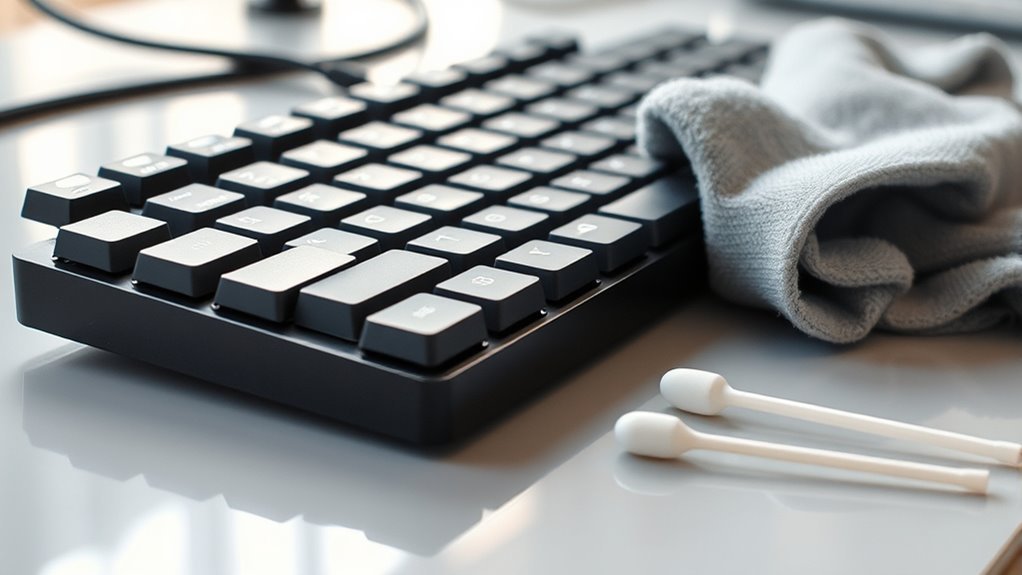
When cleaning your mechanical keyboard, remove keycaps carefully to access debris and sanitize surfaces without damaging switches. For membrane keyboards, avoid excessive moisture and use gentle cleaning agents to preserve the membrane’s integrity. Always apply safe sanitizing techniques to prevent corrosion and maintain peak functionality. Using gentle cleaning agents helps protect keyboard materials and avoid damage during cleaning.
Mechanical Keyboard Cleaning Steps
Cleaning a mechanical keyboard involves several key steps to guarantee peak performance and hygiene. Proper mechanical maintenance starts with careful keycap removal to avoid damaging switches. Once keycaps are off, you can access the board underneath for a deeper clean. Follow these essential steps:
- Use compressed air to dislodge dust and debris from the switch housing and PCB.
- Gently clean keycaps with a mild detergent solution and let them dry completely.
- Wipe the keyboard surface with isopropyl alcohol on a lint-free cloth for sanitization.
- Reattach the keycaps precisely to maintain ideal switch feel and functionality.
Membrane Keyboard Care Tips
Although membrane keyboards differ greatly from mechanical ones in construction, they still require regular maintenance to guarantee peak performance and hygiene. Effective membrane keyboard maintenance focuses on preserving the silicone dome’s integrity and ensuring keyboard surface protection against dirt and moisture.
| Task | Recommended Action |
|---|---|
| Surface Cleaning | Use a damp microfiber cloth; avoid excess liquid |
| Keycap Removal | Generally not recommended; clean carefully around keys |
| Debris Prevention | Employ keyboard covers to block contaminants |
Safe Sanitizing Techniques
Maintaining your keyboard’s hygiene goes beyond routine surface care, especially when considering both mechanical and membrane types. To achieve safe cleaning without damaging internal components, adhere to precise hygiene practices. First, disconnect your keyboard to avoid electrical issues. Use isopropyl alcohol at 70% concentration, applying it sparingly with a microfiber cloth. Avoid saturating the device to prevent liquid ingress. For mechanical keyboards, remove keycaps to clean underlying surfaces and switches carefully. Membrane keyboards require gentler wiping without key removal to preserve delicate membranes. Employ compressed air to dislodge debris effectively before wiping. Remember these tips for ideal sanitation:
- Disconnect before cleaning to guarantee safety
- Use 70% isopropyl alcohol with minimal moisture
- Remove keycaps on mechanical keyboards for thorough cleaning
- Utilize compressed air to clear debris without contact
These safe cleaning methods uphold your keyboard’s longevity and your freedom from contaminants.
How Often Should You Clean Your Keyboard?
How often should you sanitize your keyboard to guarantee optimal hygiene and performance? Establishing a consistent keyboard cleaning frequency is essential for maintaining device integrity and user health. For best results, integrate keyboard sanitation into your keyboard upkeep schedule at least once a week. This frequency mitigates microbial buildup and prevents key malfunctions caused by debris accumulation. In high-use or shared environments, increase this cadence to bi-weekly or even daily, depending on exposure levels. Adhering to a disciplined keyboard upkeep schedule not only preserves functionality but also extends the keyboard’s lifespan. By proactively managing cleaning intervals, you guarantee a reliable, hygienic interface, granting you the freedom to work efficiently without interruption or concern over contamination. Regular cleaning supports a healthier, more productive space, enhancing both your work environment and well-being.
Preventative Measures to Keep Your Keyboard Clean Longer
Regularly cleaning your keyboard is a key step, but taking preventative measures can greatly extend the time between cleanings. Adopting effective preventative habits guarantees your keyboard stays free from contaminants and maintains peak functionality. You should:
Taking proactive steps ensures your keyboard remains clean and fully functional longer between cleanings.
- Utilize a keyboard cover to shield keys from dust, debris, and spills.
- Wash your hands before typing to minimize oil and dirt transfer.
- Avoid eating or drinking near your keyboard to prevent residue buildup.
- Store the keyboard in a dust-free environment when not in use.
Incorporating these technical practices not only preserves cleanliness but also protects your investment, granting you the freedom to focus on productivity without frequent interruptions for sanitation. Additionally, using compressed air dusters can help remove dust and debris from tight spaces without damaging the fabric.
Frequently Asked Questions
Can Keyboard Covers Reduce the Need for Frequent Cleaning?
Ever wonder how you can maintain a cleaner workspace with less hassle? Using keyboard covers offers significant keyboard cover benefits by acting as a barrier against dust, spills, and debris. This protective layer can effectively reduce cleaning frequency since contaminants don’t directly contact the keyboard. While covers don’t eliminate the need for sanitation, they simplify maintenance and extend intervals between cleanings, giving you more freedom to focus on your tasks without constant upkeep.
Is It Safe to Use UV Light Sanitizers on Keyboards?
You can safely use UV light sanitizers on keyboards if you follow guidelines guaranteeing UV light effectiveness and safety. UV-C light effectively inactivates microbes on surfaces, but exposure time and distance matter. Avoid direct skin or eye exposure, as UV-C can harm tissues. Ascertain your device’s intensity and duration meet recommended standards for disinfection without damaging the keyboard. Proper handling lets you harness UV light’s power while protecting yourself.
How Does Keyboard Material Affect Cleaning Methods?
When you clean plastic vs. metal keyboards, you need different approaches. Plastic keycaps can tolerate gentle alcohol wipes, but harsh chemicals might degrade them. Metal surfaces withstand stronger solvents but may tarnish if not dried properly. Keycap material guides your choice: ABS plastic demands less moisture and milder agents, while PBT plastic handles more rigorous cleaning. Understanding these differences lets you sanitize freely without damaging your keyboard’s integrity or finish.
Can Cleaning Damage the Keyboard Warranty?
You should carefully review your keyboard’s warranty policies before cleaning it, as certain cleaning methods might void your warranty. Many manufacturers specify approved cleaning techniques and prohibit using harsh chemicals or excessive moisture. To maintain warranty coverage while keeping your keyboard sanitized, stick to recommended methods like using isopropyl alcohol wipes sparingly. Understanding these policies lets you clean confidently without risking your device’s protection or functionality.
Are Wireless Keyboards More Hygienic Than Wired Ones?
Imagine switching from a gas car to an electric bike—wireless technology offers similar freedom. Wireless keyboards reduce clutter, making it easier to clean surfaces without tangled cables trapping dust and grime. While the hygiene benefits aren’t due to the signal itself, the absence of wires minimizes crevices where germs hide. So, if you value ease and thorough sanitation, wireless keyboards give you more control over maintaining a cleaner workspace.
